| Please access the following URL if you want to secure using SSL. All pages in the site will be secure pages. |
https://secure02.blue.shared-server.net/www.fish-food.co.jp/message english 9.2022.html |
Welcome to FISH FOOD TIMES
Sep. 2022 issue No.225

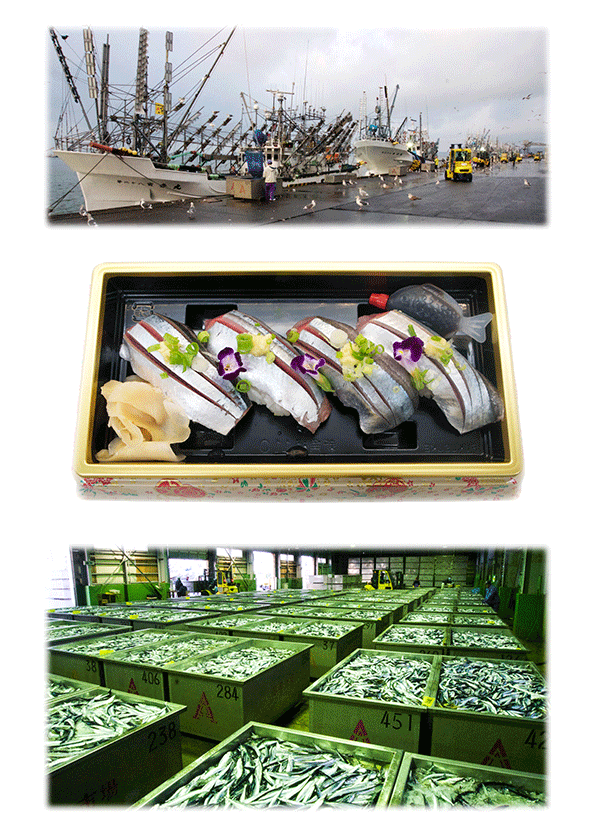
Pacific saury nigiri sushi
What will happen to this year's saury
This image was taken by the author on November 3, 2017 at Akkeshi fishing port in Hokkaido.
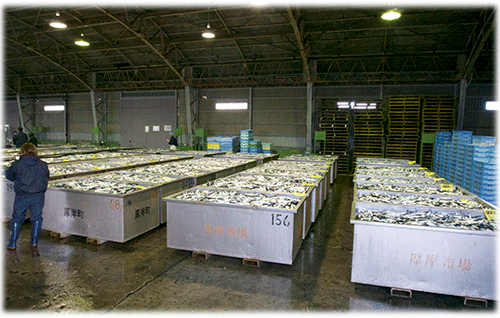
At this time, despite the fact that the majority of fish schools had already moved to the Sanriku coast, countless 1-ton containers called tanks were lined up in the indoor auction area of Akkeshi Fish Market. The container was full of saury, and there was something that surprised me with the overwhelming amount of saury that landed at the fish market.
You might think that this scene was from a time when there were a lot of saury, but in fact it was the year when the saury fishing was said to be the worst catch in history. In 2017, the total catch of saury in Japan was 77,169 tons, which was the worst saury catch year in history.
The following year, 2018, the catch of saury reached 119,930 tons, a 55% increase over the previous year. However, it was only a short-lived thing, and the saury catch continued to decrease from 2019 onwards, and finally the national saury catch in fiscal 2021 fell to 16,643 tons.
At the end of July, the National Research Institute of Fisheries Resources announced the saury fishing forecast for this year. The following is an excerpt from its contents.
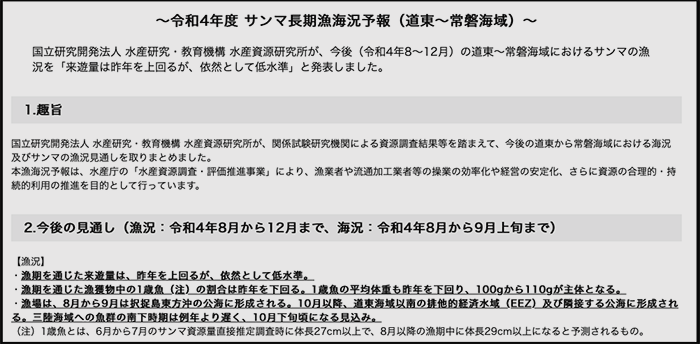
To summarize, this year's pacific saury catch is likely to be slightly higher than last year's, but the type is smaller and the time to move southward will be later than usual.
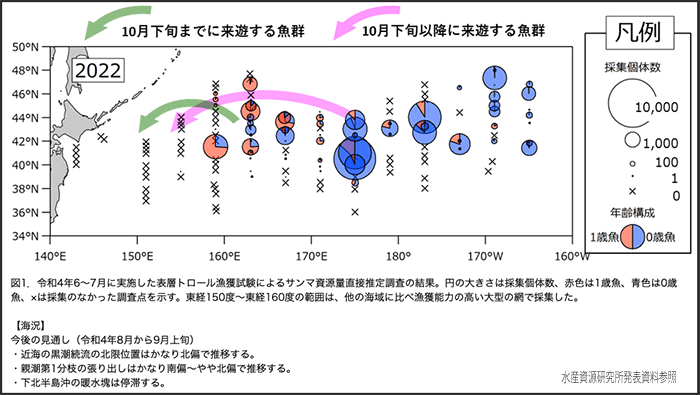
Pacific saury is a migratory fish, and as shown in the above figure, it comes from the high seas of the Pacific Ocean to the waters near Japan in autumn, so in Japan it has long been treated as "an autumn tradition'' that tells the arrival of the autumn season. However, as foreign fishing boats began to catch large amounts of saury in the Pacific Ocean before they came to Japan, the number of saury visiting the waters near Japan decreased, and the catch of saury also decreased accordingly.
Please see the graph below. This graph shows that.
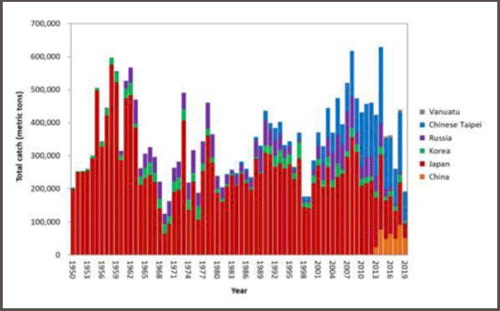
Until the 1980s, Japan and Russia were basically the only countries that caught saury in the world. Until then, Japan had a monopoly on almost 100% of the saury catch. However, in the 1990s, Taiwan started saury fishing, and then Korea joined, and Japan's saury catch share became about 50%. Furthermore, in the 2010s, China entered the saury competition, and even the Republic of Vanuatu, a small island nation in the Pacific that just became independent in 1980, began saury fishing. And Japan's saury catch share fell to about 20%.
The saury catches of each country are discussed at the annual meeting of the North Pacific Fisheries Commission (NPFC), which discusses saury resource management measures. This meeting is a framework in which nine countries and regions, including Japan, China, Taiwan, and Russia, are members.At last year's meeting, it was agreed that the two-year catch quota for 2021 and 2022 would be 330,000 tons. However, although this figure is reported to be a 40% reduction in 2020, the actual catch in 2020 is actually 140,000 tons. Moreover, Japan's catch quota for 2021 is set at 155,000 tons, but the actual catch in 2020 was only 30,000 tons, one-fifth of that. Furthermore, in 2021, as mentioned above, it has decreased sharply to 16,643 tons, which is half of that.
This figure, issued by the North Pacific Fisheries Commission (NPFC) last year, is completely meaningless because it does not match the current state of saury catches. In other words, since the catch quota is too large for the actual situation, it is essentially an "all-you-can-catch". If this all-you-can-catch situation continues in the future, the saury resource may become more and more depleted, and the catch may continue to decline.
What to do with Pacific saury that has become scarce and the price has risen
Given the reality of the saury resource situation, the fact that in the past fresh saury that could be used as sashimi was sold for 100 yen per fish seems to be becoming an old story.
What surprised me the most about saury sales was that thawed saury caught off the coast of Hokkaido and Sanriku in Okinawa had a large presence all year round. The normal selling price is basically 100 yen or less per fish, and most of them are processed and sold, and saury was one of the main players in the fish market.
The author was born in Fukuoka, Kyushu, and still lives there. Based on the sense of the environment in which I grew up, saury was salted and dried, and raw saury was regarded as a special position of freshness that can be made into sashimi. However, since 2008, the author has been instructing the seafood department of a supermarket in Okinawa, and when he observed the actual situation of the fish sales floor, he found that the defrosted Pacific saury that he opened was one of the main products in the fish sales floor. I was astonished to know the truth.
People who were born and raised in Okinawa (Uchinancyu) do not have the habit of eating fish grilled on a net, so I hear that many Uchinancyu households do not use the grill in the kitchen almost all year round. Instead, fish is often baked in butter using a frying pan, and when it comes to the suitable fish for that, it is definitely more convenient to open a thawed saury rather than a round horse mackerel. In addition, saury is cheap and delicious. Therefore, saury is seen as an honor student that meets the needs of everyone at Uchinancyu.
I wonder what is going on with the defrosted Pacific saury products that have made such a strong presence in the fish departments of Okinawan supermarkets. With the end of my 13 years of guidance in the fisheries sector in Okinawa in February 2021, I can no longer see the actual situation, so I would like to make my own guesses. Frozen saury imported from Taiwan and China have taken the place of expensive Japanese frozen saury, and thawed saury may still be sold as cheaply as ever. However, if that is the case, since they must have been caught in the high seas of the Pacific Ocean, it is presumed that most of them are lean, thin saury with no fat on them.
Over the past few years, the price of saury landed in Japan has changed as shown in the graph below. It is unthinkable that this trend will change and prices will become cheaper in Japan's current economic situation of high prices. Moreover, I suspect that even frozen saury imported from Taiwan or China will not receive much benefit under the current weak yen situation.
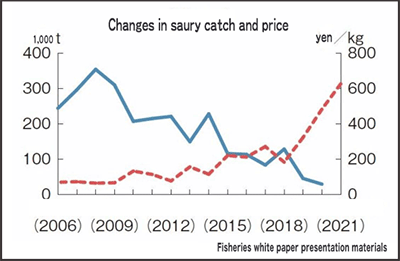
It is impossible to know how the standard of Pacific saury purchased in Okinawa has changed, and how the purchase cost and selling price have changed. However, it is speculated that there will be no change in selling products in the form of open saury products as a base.
The thawed pacific saury open product, which is the main product in the fish section of Okinawa's supermarkets, is basically commercialized through in-store work. The reason for this is that blue fish have a product characteristic of quickly discoloring, and if they are not sold out within a short period of time after being opened, the value will drop and the price will have to be lowered.
The thawed pacific saury open product work done in the fisheries department workshop of a supermarket in Okinawa was quite skillful, and even the author was amazed at the work speed and completion of those who were accustomed to it. Therefore, let us introduce the Okinawa-style saury opening work below.
| pacific saury open product working method | |
|---|---|
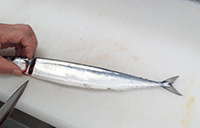 |
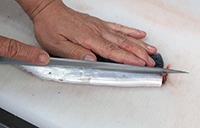 |
| 1,From the flow of work, I dared to deviate from the basic technique principle, put the head to the left, the belly body to the front, and use the Yanagiba blade to remove the head. | 6,Turn the head side to the right and make a shallow cut in the belly body on the lower body side from the head side to the tail side. |
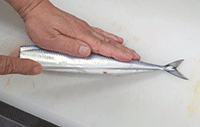 |
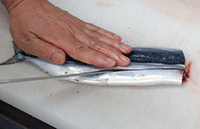 |
| 2,With the head side to the left, make a shallow incision on the upper body side of the abdomen from the tail to the head. | 7,The point to note at this time is to cut the top of the centralbone without cutting the belly bone as with the upper body side. |
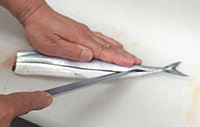 |
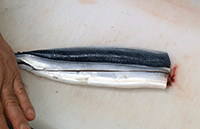 |
| 3,Cut open from the cut end of the tail towards the head. At this time, do not cut the belly bone, but cut over the belly bone and centralbone. | 8,Cut the cut open lower body side further, cut off between the centralbone and the backbone, and finally cut off the centralbone that connects the tail and the abdomen. |
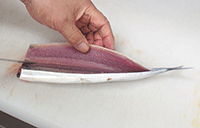 |
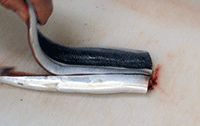 |
| 4,Using the tip of a knife, cut open to the edge, leaving a piece of skin. | 9,Lift the tail side and separate it from the abdomen where the internal organs remain. |
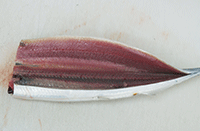 |
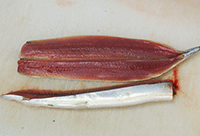 |
| 5,The state where the internal organs of the abdomen are left intact and the upper body side is cut open. | 10,The abdomen where the internal organs are left intact, and the separated part with the tail fin still attached. |
The work method introduced above can be done in the same way for sardines, and I am planning to make an open product for round sardines in the same way.
Don't be pessimistic
Since I touched on sardines, I would like to mention a little more about sardines.
In 1988, about 4.5 million tons of sardines were caught in Japan. Prior to that, in 1965, there was a year in which only 9,000 tons were caught, but after that, around 1990, the catches followed a gradual downward trend.
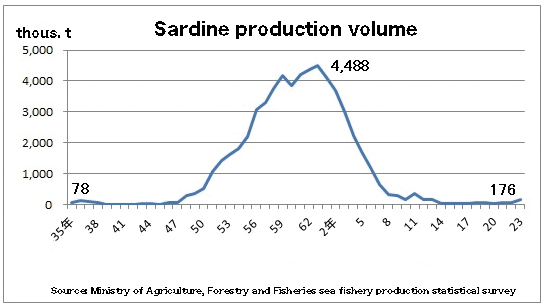
Because it was like this, it was also called "phantom fish" for a while. However, there is a fact that sardine stock recovery has become conspicuous little by little in recent years, and the graph below shows this fact.
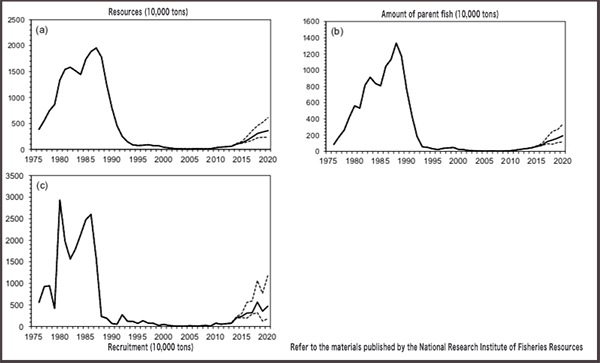
As a result of scientific research on sardine resources by the National Research Institute of Fisheries Resources, it is predicted that sardine resources will continue to gradually recover in the future.
Similarly, the Pacific saury will never be pessimistic in the future, and it may be possible to think that the resource may be revived. Fish retailers should take this as wishful thinking, calmly accept the current reality of saury, and think about what to do in the future.
If the catch of Pacific saury does not recover at present and for the time being and the market price remains high, there is no choice but to develop products accordingly. If the purchase price is high, you should of course add value to the product to satisfy the customer, and have the customer purchase it with that understanding.
And I think the best way to do that is to provide fresh raw saury in the form of high value-added raw food such as sashimi and sushi, but the formidable enemy that stands in the way is Anisakis. Without proper measures against Anisakis, it is basically impossible to sell raw saury products.
Currently, most supermarkets, mainly major ones, prohibit the sale of not only saury, but also mackerel and sardines as raw food products. This is because supermarket managers are concerned about causing the Anisakis problem, and take a distorted safety measure that they do not cross dangerous bridges, and even if they knock on stone bridges, they do not cross.
The author, who has lived as a fishery-related person for a long time, cannot stand this fact. In Fukuoka, mackerel sashimi called gomasaba has a long history of being eaten as one of the traditional food customs. A supermarket with its head office in Fukuoka, which has multiple stores, does not sell fresh wild mackerel on the sales floor as being for eating raw, and sells them all with labels for fillets. . And only relatively expensive cultured mackerel is sold for sashimi because it is guaranteed to be free of Anisakis.
Measures against Anisakis
As mentioned above, in order to sell saury at a reasonable price, it is required to add value by making saury sashimi and sushi for eating raw, but the barrier of Anisakis exists as a troublesome problem that prevents this.
Until now, the only way to kill Anisakis without heating was to freeze it at under -20°C for at least 24 hours. However, there is no way a fish retailer that sells sashimi and sushi that is based on raw fish can do that. As a realistic action, there is no choice but to do the work of checking with one's own eyes when fish are received and cooking them, and removing any Anisakis.
At the factory level, seafood processing company Japan Seafoods (Fukuoka City, President Yoichi Inoue) and Associate Professor Takao Namihira of Kumamoto University's Industrial Nanomaterials Research Institute (Kumamoto City) have electrocuted Anisakis with instantaneous enormous power (pulse power). It is said that they have jointly developed a new method of killing them by letting them die. As a result, the risk of Anisakis food poisoning for non-frozen sashimi for raw consumption has approached zero.
Machines and simple devices for discovering Anisakis by exposing them to ultraviolet light called black light have also been put on the market. However, even if large factories can do that in terms of cost and time, retailers all over the country do not have time to do that for all popular blue fish such as saury, mackerel, sardines, and horse mackerel.
Fish retail professionals must make full use of their experience and knowledge to ensure that no Anisakis incident occurs. Readers of FISH FOOD TIMES are probably all familiar with this, but let's organize a little bit of knowledge about Anisakis in order to sell saury as a raw food product again.
Anisakis is abundant in the internal organs of fish, and does not migrate from the internal organs when it is cold, such as in ice-salt water. However, when the ice becomes scarce, it may move from the internal organs to the meat. That's why you don't have to worry about that if you remove the internal organs while they are still as fresh as possible. However, the problem is when Anisakis migrates to the body over time. Even if it moves to the body, it is easy to find it because it is hidden in the meat near the internal organs when it is still fresh enough to be eaten raw.
For example, the "cyst (Anisakis nest)" is surrounded by a white frame in the image below, but it is swirling black, so it is relatively easy for anyone to see. However, it should be noted that the black color will darken as time passes, so it is difficult to check while the fish is still fresh.
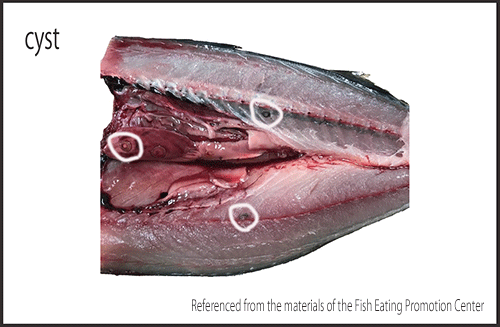
In this way, there is no choice but to thoroughly carry out "visual confirmation" to check with your own eyes at the fish retail site.
By the way, did you know that the severe pain symptoms of Anisakis poisoning are not physical pain from biting or stabbing? Since Anisakis has no mouth and is a small creature less than 1 mm in diameter, food poisoning is thought to occur when the allergens secreted by living Anisakis react with the stomach wall. In the case of primary infection, the symptoms are mild and palliative because they are limited to foreign body reactions, and reinfection causes strong immediate hypersensitivity reactions and becomes fulminant.In other words, a person who has anisakis food poisoning will have a mild anisakis allergy for the first time, and will feel fulminant pain for the second time. Currently, 14 Anisakis allergens have been identified. And it is said that about half of the food poisoning (urticaria) caused by histamine, which is said to be common in red-fleshed fish such as tuna and mackerel, including saury, may be allergic to Anisakis.
Anisakis is quite troublesome, but Seirogan is attracting attention as an antidote. The author mentioned this in his FISH FOOD TIMES No.214 in October last year, so if you haven't read it yet, please refer to it.
Let's sell saury as sashimi and sushi
Well, I've mentioned Anisakis at length. This is because I want the saury, which has become more expensive than in the past, to be sold not only for salt-grilled saury, but also for sashimi and sushi, which have high added value.
In the past, I have eaten extra-large raw saury as sashimi and sushi. I remember that the texture of the fat was melting on the tongue, and the taste was really exceptional. Such an extra-large size has not been seen for several years, and even if you ask an intermediate wholesaler, it is almost impossible to get it because the tendency of saury to become smaller is remarkable.
The image below shows the nigiri-zushi made using the extra-large saury on Thursday, September 4, 2014.
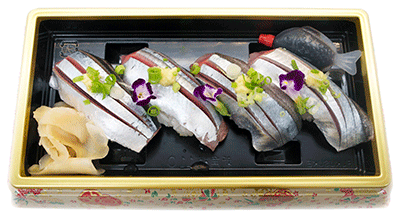
I think the weight of one fish was definitely over 200g, but I don't know the exact weight because I didn't weigh it. I think it was about 18 to 15 fish in a 4kg standard seawater ice styrofoam box, but it was 8 years ago so I don't remember exactly. However, strangely enough, when I look at this image, I can remember the area, company, store, names and faces of the main people who were there, and what kind of conversation they had. For the author himself, this saury nigiri sushi is such an impressive work.
This work was not put on the market as a product, and all the participants including the author tasted it as a prototype. At the same time, I was trying to commercialize broiled nigiri sushi and sashimi using the same extra-large saury. Below is the image.

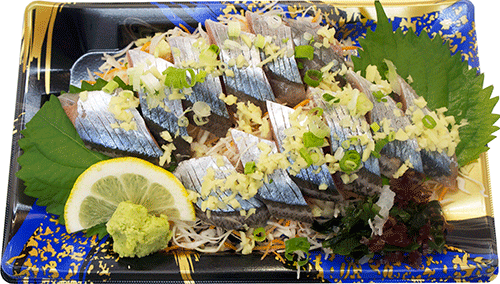
Now, I think it will be difficult to make sashimi and sushi with such a dynamic volume. After all, as mentioned above, while the Pacific saury is still small, it is caught by foreign fishing boats in the high seas of the Pacific Ocean. Therefore, even if the rest of the saury comes to the waters around Japan, it is generally small and you can hardly see the saury that has grown to a large size.
Not only saury, but also mackerel, sardines, and other blue fish, greasy is the decisive factor in their deliciousness. Greasy is basically proportional to size, so the bigger the fish, the more valuable it is. However, in the past few years, given the saury resource situation as you know, there's nothing you can do if you want something you can't get, and you'll have to buy and sell the size you can get at a reasonable price. Just as sardines used to be called phantom fish, I just want to avoid saury being treated as a phantom fish.
I am not in a position to say anything about the Pacific saury fishery, and I can only say what to do with the fish that have landed on land. For this reason, once the fish are on land, I would like to do my best to handle them with care so that customers can eat them deliciously.
The author recognizes that FISH FOOD TIIMES includes people in various positions related to fisheries, not just fish retailers who are assumed to be readers of this website. I think it is also important for such people to know what a person like the author, who is involved in fish retailing, thinks about fisheries. And I think that readers in various positions can share the idea that "Japan's fish-eating culture", which has continued for a long time, should not be neglected.
I would like to make efforts in each position so that saury, which is a seasonal feature of autumn, does not become a phantom fish.
| Please access the following URL if you want to secure using SSL. All pages in the site will be secure pages. |
https://secure02.blue.shared-server.net/www.fish-food.co.jp/message english 9.2022.html |
An opinion and the communication are to iinfo@fish food times
Date of updating 1 Sep. 2022
